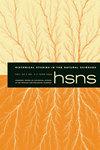显微镜下的犰狳
IF 0.3
3区 哲学
Q2 HISTORY & PHILOSOPHY OF SCIENCE
引用次数: 0
摘要
在19世纪,一种来自美洲的动物犰狳为从事研究四肢脊椎动物外壳及其组成部分的动物学家提供了一个非凡的研究对象。犰狳是一种身背铁甲的哺乳动物,自16世纪初以来,它就引起了欧洲博物学家的好奇心,它们的贝壳也因此成为收藏品中的一道常见风景线。犰狳的甲壳提供了一种可以通过仔细观察来了解动物物质的结构,这种结构为显微镜和化学在新兴生命科学中的应用提供了条件,这些生命科学试图理解形式和功能之间的关系以及有生命物质的化学成分。犰狳的甲壳最初是在好奇心的驱使下被收集起来的,而现在却被转移到了动物化学的新领域,这一关键举动对历史学家理解动物材料研究的兴起至关重要。犰狳伴随着化学、显微镜和物理学的发展,因为它们被用来研究构成哺乳动物皮肤覆盖物的材料。本文从19世纪的出版物中挖掘出与这一壳的解剖学和化学构造研究的漫长故事有关的章节,以及它在新科学知识的出现和新生物灵感材料的发现中所起的关键作用,这些材料至今仍来自于这种动物。这篇论文是劳伦斯·道尼和丽莎·奥永编辑的题为“及时制作动物材料”的特刊的一部分。本文章由计算机程序翻译,如有差异,请以英文原文为准。
Armadillos under the Microscope
In the nineteenth century, an animal from the Americas known as the armadillo offered an extraordinary subject for zoologists engaged in the study of the outer covering of four-limbed vertebrates and its components. The armadillo, a cuirassed living mammal, had excited the curiosity of European naturalists since the early sixteenth century, and their shells had thus become a common sight in collections. The armadillo’s carapace provided a structure that could be scrutinized in order to understand animal materials, one that afforded the use of microscopes and chemistry in the emerging life sciences that tried to understand the relationship between form and function and the chemical composition of animated matter. The carapace of the armadillo moved from the culture of curiosity in which it was first collected into the new field of animal chemistry, a key move that is crucial for historians to understand the emergence of the study of animal materials. Armadillos accompanied the expansion of chemistry, microscopy, and physics as they were used to study the materials that constituted the mammals’ dermal coverings. This paper mines nineteenth-century publications for episodes connected to the long story of the study of this shell’s anatomical and chemical contrivances, and the crucial role it played both in the emergence of new scientific knowledge and in the discovery of new bio-inspired materials still derived from this animal today. This paper is part of a special issue entitled “Making Animal Materials in Time,” edited by Laurence Douny and Lisa Onaga.
求助全文
通过发布文献求助,成功后即可免费获取论文全文。
去求助
来源期刊

Historical Studies in the Natural Sciences
社会科学-科学史与科学哲学
CiteScore
1.00
自引率
0.00%
发文量
24
审稿时长
>12 weeks
期刊介绍:
Explore the fascinating world of Historical Studies in the Natural Sciences, a journal that reveals the history of science as it has developed since the 18th century. HSNS offers in-depth articles on a wide range of scientific fields, their social and cultural histories and supporting institutions, including astronomy, geology, physics, genetics, natural history, chemistry, meteorology, and molecular biology. Widely regarded as a leading journal in the historiography of science and technology, HSNS increased its publication to five times per year in 2012 to expand its roster of pioneering articles and notable reviews by the most influential writers in the field.
 求助内容:
求助内容: 应助结果提醒方式:
应助结果提醒方式:


